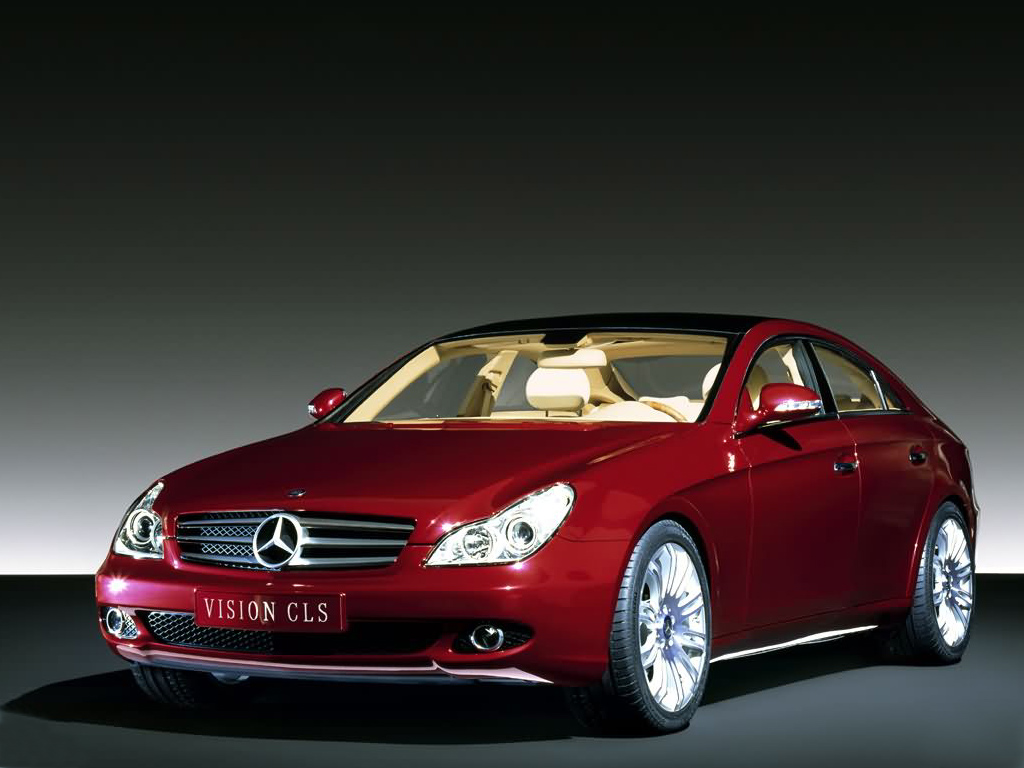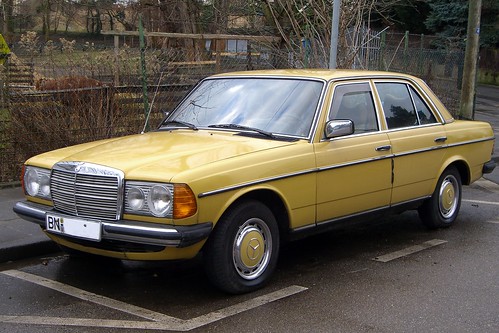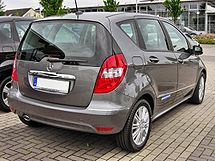Mercedes-Benz A-Class
Mercedes-Benz A-Class


|
Manufacturer
| Mercedes-Benz
|
|---|
Parent company
| Daimler-Benz
DaimlerChrysler AG (from 1998)
Daimler AG (from 2007)
|
|---|
Production
| 1997–present
|
|---|
Assembly
| Rastatt, Germany
|
|---|
Layout
| FF layout
|
|---|
Related
| Mercedes-Benz B-Class
|
|---|
The Mercedes-Benz A-Class is a luxury small car produced by the German automaker Mercedes-Benz. The first generation (W168) was introduced in 1997, and the all-new second generation model (W169) appeared in late 2004. It is available as a three or five-door hatchback. It is Mercedes' entry level model in most of its worldwide markets, though not in China or North America; the B-Class is the entry model in China, Canada and Mexico, and the C-Class is the entry model in the US.
W168
Mercedes-Benz A-Class W168


|
Production
| 1997–2004
Brazil 1999 - August 2005
|
|---|
Body style(s)
| 5-door hatchback
|
|---|
Layout
| FF layout
|
|---|
Platform
| Mercedes-Benz W168
|
|---|
Engine(s)
| 1.4L I4
1.6L I4
1.7L I4
1.9L I4
2.1L I4
|
|---|
Wheelbase
| 2,423 mm (95.4 in)
|
|---|
Length
| 3,606 mm (142.0 in)
|
|---|
Width
| 1,719 mm (67.7 in)
|
|---|
Height
| 1,587 mm (62.5 in)
|
|---|
Production of the W168 A-Class began in 1997. Its front engine, front wheel drive layout was quite unusual for Mercedes. To date, about 1.6 million units have been sold worldwide.
One innovation of the W168 was a frontal-impact absorption system called the "Sandwich" (see patents DE4326 9 and DE4400132 in the name of Mercedes-Benz). In the event of a violent frontal impact, the engine and transmission would slide underneath the floor below the pedals rather than entering the passenger compartment.
The W168 became infamous in 1997 after flipping over during the traditional "moose test" performed by the Swedish automobile publication Teknikens Värld. According to the report, the W168 overturned when maneuvering to avoid the "moose". Mercedes initially denied the problem, but then took the surprising step of recalling all units sold to date (2,600) and suspending distribution until the problem was solved by adding electronic stability control and modifying the suspension. This marked the world première of stability control in a small car.
W169
Mercedes-Benz A-Class W169
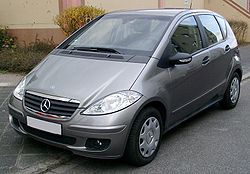
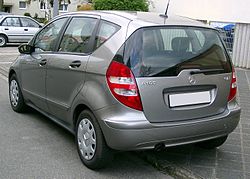
|
Production
| 2004–present
|
|---|
Body style(s)
| 5-door hatchback
3-door hatchback
|
|---|
Layout
| FF layout
|
|---|
Platform
| Mercedes-Benz W169
|
|---|
Engine(s)
| 2.0L Diesel I4
1.5L I4
1.7L I4
2.0L I4
|
|---|
Transmission(s)
| 5-speed manual
6-speed manual
CVT
|
|---|
Length
| 2004-08: 3,838 mm (151.1 in)
2009- 3,883 mm (152.9 in)
|
|---|
Width
| 1,764 mm (69.4 in)
|
|---|
Height
| 1,593 mm (62.7 in)
|
|---|
Driving assistance
The car is designed according to Mercedes-Benz concept of 'Touch And Feel' (TAF).
The multi-function steering wheel places controls for the radio, telephone, and other systems conveniently within reach of the thumbs of the driver. Power steering (standard feature) aids control of the automobile, with its behaviour varying according to the vehicle's speed.
The Mercedes COMAND APS is a navigation system which provides directions via GPS. The radio unit also provides DVD and telephone functionality, with various versions available (standard Audio 20 radio/single CD, Audio 50 APS or COMAND APS).
The Parktronic system provides audio and visual signals to indicate how far the car is from an obstacle.
The A-class optionally includes a "Light & Sight" package which includes bi-xenon HID headlamps with gas-discharge bulbs; cornering lights (main-beam headlamps at road junctions and tight corners); "Headlamp Assist, which automatically turns on the lights when needed; and a rain sensor that adjusts wiper speed depending on rainfall intensity.
As a standard feature, when entering a tunnel or an underground garage the car goes into "tunnel mode", where all windows and the panoramic sliding sunroof are closed.
Temperature control
The standard temperature control system has separate temperature settings for driver and front passenger sides, and includes a "Heater Booster System" that can flood the interior of the car with hot air.
The optional Themotronic system maintains and regulates the temperature in accordance with a set of sensors that measure temperature, sunlight, humidity and pollutant levels in the ambient air.
Safety
A number of new features were made available in the W169 model.
The biggest was the immediate fitment of a newly invented device, Electronic Stability Control. ESP is standard on every Mercedes-Benz (produced after 1999).
The car is constructed with high-strength steel alloys with bonded joints. It has a large number of airbags including optional rear side airbags (for side-impacts in the backseats), optional side-curtain airbags, and standard head and thorax-protection side airbags. The front airbags are adaptive with two-stage gas generators operating according to the severity of accident.
The force exerted by the seat belt system during a collision adapts dynamically depending upon the collision characteristics. The 'active' head restraints (standard for driver and front passenger) give enhanced protection from neck injury, especially during rear collisions.
The angle of the A-pillar is flatter than the windshield angle.
In 1997 the journalist Robert Collin from the motor magazine Teknikens Värld overturned the new Mercedes-Benz A-Class in the moose test, while a Trabant — a much older, and widely mocked car from the former German Democratic Republic — managed it perfectly.
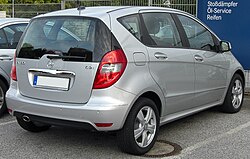 Facelifted A-Class W169
Facelifted A-Class W169
Passenger and cargo spaceThe cargo capacity of the W169 was increased by 15 percent compared with the W168. The seats can be moved and configured in various ways:
- EASY-ENTRY: Front seats slides forwards with the backrest folded forwards to afford the rear seat passengers more room for getting in and out. (standard on three-door)
- EASY-VARIO: Both rear-seat cushion sections are folded forward, while the luggage compartment floor can be set to one of two different heights. (standard on five-door; optional on three-door)
- EASY-VARIO-PLUS: Both rear-seat cushion and the front passenger seat are folded forward. Increases load capacity to as much as 1995 litres. (optional on five-door)
Engine and drive system
Seven types of motors are available, and all are four-cylinders: four petrol (gasoline) (A150, A170, A200, A200Turbo) and three diesel (160CDI, 180CDI, 200CDI) partnered with either 5 or 6-speed manual gearbox. A continuously variable transmission system called "Autotronic Constantly Variable Transmission" (CVT) is an optional feature.
The petrol A200 Turbo provides 193 hp (144 kW) and 280 N·m (207 lb·ft) of torque (rotational force); the diesel A200 CDI has 140 hp (104 kW) and 300 N·m (221 lb·ft).
It is estimated that the W169 engines provide a 40% increase in power and a 10% decrease in fuel consumption compared to W168 engines.
The most powerful model can take the car from a standstill to 100 km/h (62 mph) in 8.0 seconds, and has a top speed of 218 km/h (135 mph).
The newly developed direct-injection CDI diesel units use a common-rail direct injection system that improves fuel consumption and reduces exhaust emissions and noise levels.
All the engines meet the tight EU4 emissions limits. A particulate filter system is available as an option for the diesel units which reduces the particulate emissions by about 99% without the need for additives.
The A-Class is a front wheel drive car and features traction control (ASR) as standard, as well as electronic stability control and anti-lock brakes (ABS).
Handling is improved by precision tracking and anti-roll support, and by a Parabolic Rear Axle.
A "Selective Damping System", in which the shock absorber forces respond differently according to conditions, is standard. For example, under normal conditions it operates at soft absorption; while cornering at speed it changes to full damping force.
The W169 optionally comes with light-alloy wheels, with a run-flat feature, Tirefit tire sealant and a tire-pressure-loss warning device.
Tire sizes are:
- 185/65 R 15 with wheel trim (classic model)
- 185/65 R 15 light-alloy wheels (elegance model)
- 195/55 R 16 light-alloy wheels (avantgarde model)
W169 facelift
The 2009 A-Class (W169 Facelift) features redesigned front and rear bumpers, new tail lamps and headlights, new grille, new exterior mirrors, a restyled interior design and new upholsteries and colors. The 2009 A-Class was released alongside the refreshed 2009 M-Class and B-Class. The car is also available with Active Park Assist, which enables the car to parallel park itself, with only throttle and brake inputs required from the driver.
Initial advertising campaign for the W169
A four-day, seven-country tour which officially introduced the car culminated in an event in Milan, in the Castello Sforzesco, where all the touring units were received by a myriad of European personalities from music, fashion, sport and movies. Armani presented a fashion show and Christina Aguilera did a live performance of her song "Hello", composed exclusively for the occasion.
The W169 advertising campaign included television spots with Christina Aguilera, Giorgio Armani and Boris Becker.

Mercedes-Benz A-Class F-Cell concept
Production
Sales of the W169 were targeted at 50,000 units in 2004. Dr. Joachim Schmidt, Executive Vice President Sales and Marketing, Mercedes Car Group, said that target had been reached even before vehicles arrived in dealer showrooms.
DaimlerChrysler invested EUR 900 million in developing the Rastatt plant where the A-Class is produced, and created 1600 new jobs (for a total of 4700). A further 600 people work on the industrial estate at the plant site.
In 1999, Mercedes Benz opened, in Juiz de Fora, Minas Gerais (Brazil), its first factory in South America dedicated to passenger cars, with an investment of USD 840 million and 10,000 employees. The factory initially produced A-Class and C-Class models, assembling them from pieces manufactured in Germany. The target for the cars was regional markets (from Argentina to Mexico) with modifications made to the cars to suit local conditions, like a protection for the motor base for the mostly poor roads in South America. In 2005 the factory stopped production of A-Class cars.
Profitability and impact on the Mercedes-Benz brand
Mercedes-Benz has made a number of confusing announcements - first that a "weak Euro" could produce costs problems and later that the "fall of the Dollar" will cause the enterprise to not be profitable.
According to some analyses, Mercedes-Benz considers the creation of the A-Class to have reduced its prestige in Europe, and the company has concentrated its efforts on its larger and more profitable vehicle lines.
W169
Specification
| A160 CDI
| A180 CDI
| A200 CDI
| A160
| A180
|
|
|---|
Length
| 3,838 mm (151.1 in)
| 3,838 mm (151.1 in)
| 3,838 mm (151.1 in)
| 3,838 mm (151.1 in)
| 3,838 mm (151.1 in)
|
|
Width
| 1,764 mm (69.4 in)
| 1,764 mm (69.4 in)
| 1,764 mm (69.4 in)
| 1,764 mm (69.4 in)
| 1,764 mm (69.4 in)
|
|
Height
| 1,593 mm (62.7 in)
| 1,593 mm (62.7 in)
| 1,595 mm (62.8 in)
| 1,593 mm (62.7 in)
| 1,593 mm (62.7 in)
|
|
Wheelbase
| 2,568 mm (101.1 in)
| 2,568 mm (101.1 in)
| 2,568 mm (101.1 in)
| 2,568 mm (101.1 in)
| 2,568 mm (101.1 in)
|
|
Luggage (l)
| 435-1995
| 435-1995
| 435-1995
| 435-1995
| 435-1995
|
|
(3 doors)
| 435-1485
| 435-1485
| 435-1485
| 435-1485
| 435-1485
|
|
Empty weight (5-doors)
| 1,325 kg (2,921 lb)
| 1,345 kg (2,965 lb)
| 1,365 kg (3,009 lb)
| 1,225 kg (2,701 lb)
| 1,240 kg (2,734 lb)
|
|
(3 doors)
| 1,300 kg (2,866 lb)
| 1,320 kg (2,910 lb)
| 1,340 kg (2,954 lb)
| 1,195 kg (2,635 lb)
| 1,210 kg (2,668 lb)
|
|
Tank Capacity
| 54 L (14.3 US gal; 11.9 imp gal)
| 54 L (14.3 US gal; 11.9 imp gal)
| 54 L (14.3 US gal; 11.9 imp gal)
| 54 L (14.3 US gal; 11.9 imp gal)
| 54 L (14.3 US gal; 11.9 imp gal)
|
|
Tank Reserve
| 6 L (1.6 US gal; 1.3 imp gal)
| 6 L (1.6 US gal; 1.3 imp gal)
| 6 L (1.6 US gal; 1.3 imp gal)
| 6 L (1.6 US gal; 1.3 imp gal)
| 6 L (1.6 US gal; 1.3 imp gal)
|
|
Cylinders
| 4/in-line 4-valv/cyl
| 4/in-line 4-valv/cyl
| 4/in-line 4-valv/cyl
| 4/in-line 2-valv/cyl
| 4/in-line 2-valv/cyl
|
|
Displacement cc
| 1991
| 1991
| 1991
| 1498
| 1699
|
|
Motor
| 2.0L Diesel
| 2.0L Diesel
| 2.0L Diesel
| 1.5L Petrol
| 1.7L Petrol
|
|
Fuel per 100 km
| 4.9L
| 5.2L
| 5.4L
| 6.2L
| 6.6L
|
|
Rated Output kW/ hp/ PS (rpm)
| 60/82/83 (4200)
| 80/109/111 (4200)
| 103/140/142 (4200)
| 70/95/96 (5200)
| 85/116/118 (5500)
|
|
Rated Torque
| 180 N·m (130 ft·lbf) (1400-2600)
| 250 N·m (180 ft·lbf) (1600-2600)
| 300 N·m (220 ft·lbf) (1600-2600)
| 140 N·m (100 ft·lbf) (3500-4000)
| 155 N·m (114 ft·lbf) (3500-4000)
|
|
Acceleration 0-100 km/h (sec)
| 15.0
| 10.8
| 9.5
| 12.6
| 10.9
|
|
Top Speed km/h
| 165 km/h (103 mph)
| 184 km/h (114 mph)
| 202 km/h (126 mph)
| 173 km/h (107 mph)
| 188 km/h (117 mph)
|
|
Transmission
| 5-speed manual
| 6-speed manual
| 6-speed manual
| 5-speed manual
| 5-speed manual
|
|
Wheels
| 6j x 15
| 6j x 15
| 6j x 16
| 6j x 15
| 6j x 15
|
|
Tires
| 185/65R15
| 185/65R15
| 195/55R16
| 185/65R15
| 185/65R15
|
|
A200 normal aspiration
Displacement: 2034 cc
Power: 136 PS (100 kW; 134 hp) @ 5750 rpm
Rated Torque: 185 N·m (136 ft·lbf) @ 3500 rpm - 4000 rpm
Transmission: 6-speed manual CVT
Top Speed: 195 km/h (121 mph)
Wheels: 6j x 16
Tires: 195/55 R16
W168 vs. W169
Specification
| W169 (5 door)
| W168 (standard)
|
|---|
length
| 3,838 mm (151.1 in)
| 3,606 mm (142.0 in)
|
width
| 1,764 mm (69.4 in)
| 1,719 mm (67.7 in)
|
height
| 1,593 mm (62.7 in)
| 1,587 mm (62.5 in)
|
wheelbase
| 2,568 mm (101.1 in)
| 2,423 mm (95.4 in)
|
VDA boot capacity L
| 435-1370
| 390-1190
|





